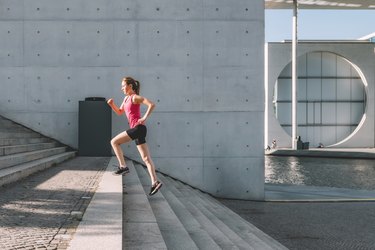
Your glutes (buttocks) and hip muscles are skeletal muscles that are heavily engaged while running. It's not uncommon to have sore glutes after running.
Causes for sore hips after running can include low potassium levels, muscle strains, a buildup of lactic acid, and delayed onset soreness.
Video of the Day
Video of the Day
Low Potassium and Heavy Exercise
Some cases of muscle pain could be caused by low levels of potassium in your bloodstream — a condition called hypokalemia. Potassium helps to manage various activities in the body, including regulation of the electric charges responsible for making muscles function properly. When you sweat — as when running — the level of potassium in your blood falls. If not replenished, it could reach such a low level as to create an imbalance, accompanied by symptoms such as muscle pain.
As described in a case study of a 33-year-old male patient published in June 2015 by Turkish Journal of Emergency Medicine, severe hypokalemia caused by heavy physical activity can lead to muscle paralysis and potentially fatal heart arrhythmia.
Because potassium is present in some foods and drinks, an imbalance can be treated at home. In addition to electrolyte-enriched sports drinks, potassium exists in relatively high amounts in potatoes with the skin on and in bananas.
Sore Hips After Running
Muscle strains can cause sore hips after running. In cases of mild to moderate strains, pain may also be coupled with muscle weakness, spasms and swelling. Severe cases may make you unable to contract the muscle due to a complete tear.
For mild strains, in-home treatment that includes rest, ice, compression and elevation should be sufficient, according to the American Academy of Orthopaedic Surgeons.
Lactic Acid and Muscle Fuel
Your muscles primarily use oxygen as fuel for movement. Depending on the intensity of your exercise, your muscle tissues may need more oxygen fuel than is readily available. When this happens, your body begins to convert secondary substances, such as carbohydrates, into fuel.
A byproduct of this process is the buildup of lactic acid in your muscles, causing painful burning sensations, such as glute pain with running. However, lactic acid buildup is temporary, and usually stops within an hour after you stop or decrease the intensity of your exercise. Since your body automatically eliminates the acid buildup, no further treatment is needed and you should experience no soreness.
Delayed Onset Muscle Soreness
If you don't experience muscle pain until about 24 hours after running, you may have delayed onset muscle soreness. As the American College of Sports Medicine reports, DOMS is caused by microscopic tears in your muscle tissues. It is a temporary condition that usually lasts for about three to five days.
At-home treatments, such as the use of massages, ice packs and over-the-counter pain medicines, are usually sufficient, according to the ACSM. Noting that DOMS isn't completely preventable, the ACSM says you may reduce the intensity of muscle soreness by pacing yourself during running, which allows your muscles to progressively adapt. Avoiding hills while running can also help prevent DOMS.
- American College of Sports Medicine: "Delayed Onset Muscle Soreness"
- Turkish Journal of Emergency Medicine: "Weakness in the Emergency Department: Hypokalemic Periodic Paralysis Induced By Strenuous Physical Activity"
- American Academy of Orthopeadic Surgeons: "Sprains, Strains and Other Soft-Tissue Injuries"
Was this article helpful?
150 Characters Max
0/150
Thank you for sharing!
Thank you for your feedback!